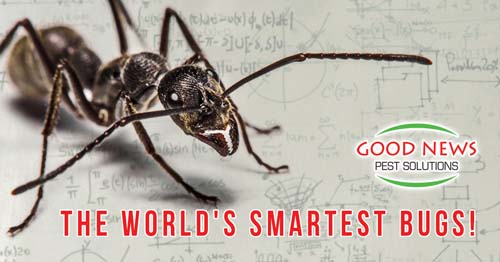
The Smartest Bugs Around!
The more we explore and learn about the world around us, the more often we find ourselves amazed at the diversity and specificity of every creature God created - from our own instincts and intellect, all the way down to our insect and arachnid cohabiters on this planet.
Naturally, from our perspective, it’s easy to see that we’re the most intelligent species on our planet. But today we want to look at some of the more intelligent, smaller-scaled creatures – the smartest bugs we’ve found.
Jumping Jehoshaphat!
Everyone knows that Spider-Man “does whatever a spider can.” Except Peter Parker has an additional trait that we don’t see in spiders. His danger-alerting spidey sense, or “Peter Tingle,” as Aunt May calls it in the recent movie, keeps him safe, but is not an arachnid trait.
However...
We’ve looked at how spiders tune their webs, parachute down onto prey, and can jump vast distances (for them). But certain spiders have an even more bizarre, yet incredibly complex attribute. In addition to vaulting distances, Jumping Spiders can utilize complex thinking to create intricate mating dances.
And to counteract their challenging vision issues, studies suggest some spiders remember where they’ve been. Scientists think they use memory to such a degree they easily locate food and prey while side-stepping obstacles in their paths. Let’s see Spider-Man pull that off!
Look to the Ant!
Twice in his far-ranging book of Proverbs, Solomon mentions the ever-industrious ant. They store food when it is plentiful to get through leaner times. And we are to consider the wisdom of their ways to grow our own understanding. But what if there was another purpose for specifically studying that ant, rather than a chipmunk or a squirrel?
In addition to their commitment to hard-working days and complex communications, ants are expert farmers! Much like the cowboys of the old west (and still in Wyoming and Montana, at least), farmer ants herd aphids like cattle. In some cases, the aphids have “stables” in an ant hill. The aphids excrement is used for food and sometimes fertilizer.
Leaf cutter ants prune trees and bring the leaves back to their mounds. They combine partially chewed leaves with their saliva to breed fungus in special greenhouse-like chambers. When it’s ready, they harvest and eat it. And similarly, attine ants grow a mycelium tissue similar to mushroom stalks underground for food (and inspiration for new technologies on Star Trek)
Parasitical Survival
In a different corner of the United States, we find Tarantula Hawks. Despite the name, these aren’t birds, but highly venomous wasps – at least if you’re a spider. Female tarantula hawks battle with tarantulas, finally injecting them with a sting that paralyzes them, but keeps them alive. She then lays her eggs inside the spider’s abdomen.
When the eggs hatch, the babies feed on the still-living spider. In fact, they’re so smart, they avoid eating the arachnid’s vital organs until they are about to reach maturity. Once they are about to pupate, they finish off the spider and fly away. Talk about a horror film!
Luckily, their sting only causes momentary pain for humans if they get bitten.
Sweet Dreams Are Made of This
Of course, no discussion of interesting and intelligent bugs would be complete without our friend, the honeybee.
Honeybees live in eusocial colonies, similar to ants – where each type of bee has a specific job. The workers who gather pollen for honey tend to follow a specific route every day. And bees can sense things seemingly beyond our understanding – the earth’s magnetic field, distances, and position of the sun.
This one element marks the honeybees as some of the most highly intelligent creatures on our planet. Once a bee finds a productive new source of pollen, it returns to the hive to share the good news - with a dance.
Scientists have termed this discovery sharing the “waggle dance.” The honeybee gets the hive’s attention. Then, with startlingly accuracy, describes with their movement the exact distance and direction of the new flower, based on the position of the sun. Talk about incredible!
Intelligent Design
One of the things we’ve learned in 30 years of offering pest solutions is there is no limit to insect’s creativity when they’re trying to find ways into your home or office. No matter how unintelligent the bugs may seem.
The good news is, those 30 years of experience comes in handy – we use the best, 100% organic, reduced-risk pest solutions you can find. Safe for you, your family and your pets. We’re proud to protect the Gulf coast of Florida, from Parrish to North Fort Myers. If you’d like more information, or to schedule your first Green Pest Control appointment, just give us a call!
« Back to BlogProudly Serving
Sun City Center, Ruskin, Palmetto, Parrish, Ellenton, Bradenton, Anna Maria, Holmes Beach, Bradenton Beach, Longboat Key, Lakewood Ranch, University Park, Myakka City, Sarasota, Siesta Key, Osprey, Nokomis, Casey Key, Venice, Englewood, North Port, Port Charlotte, Punta Gorda, Arcadia
Things You Can Do
Pay Your Bill Online
Leave Us a Review
Request a Free* Termite Inspection
Stop Mosquito Bites
Get Rid of Rodents
Get a Termite Damage Warranty
Get Pest Control for Your Attic
Get Pest Control for Your Business Request Prayer
Corporate Address
1080 Enterprise Court, Ste A
North Venice, FL 34275
Call Now: (941) 412-9610
Text: (941) 412-9610
Fax: (941) 412-0080
